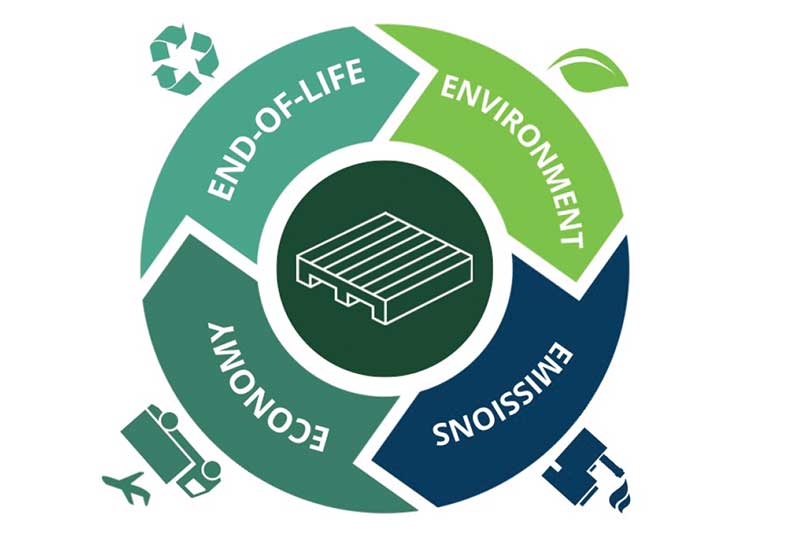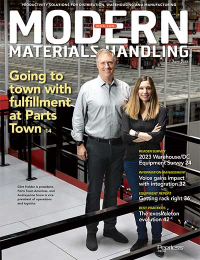What’s the environmental impact of wood pallets?
They are about as sustainable as anything can get and have a positive impact on the environment. Better yet, that’s provable with a new tool from the National Wooden Pallet & Container Association.

When sustainability is the topic, it’s really easy to get in the weeds. And sometimes, as the conversation continues, you can get lost all together.
Fortunately, that wasn’t the case recently with Brad Gething and Jason Ortega of the National Wooden Pallet & Container Association (NWPCA). Gething, vice president of science and technology, and Ortega, vice president of public affairs, were explaining the NWPCA’s Environmental Product Declaration (EPD).
Hunting for an emoji with a raised eyebrow might be your first reaction to that new acronym. But Gething and Ortega nicely unraveled what the EPD is and why it’s important to pallet producers and users.
The NWPCA’s EPD is an engineered benchmark to quantify the environmental impact of wooden pallets, explains Gething. So far so good.
Ortega continues to say “the EPD is a tool to help companies communicate to others that wooden pallets are the right choice for their efforts to minimize the supply chain’s impact on the environment.” Who can’t get behind that?
They explain that the EPD shows that wooden pallets “potentially have a climate positive effect on the environment. That means wooden pallets may go beyond achieving net zero carbon emissions and actually create an environmental benefit by removing additional carbon dioxide from the atmosphere.”
No holding back on that claim. So, how exactly is the NWPCA so sure any of this is true?
Gething spent four years working with a range of organizations from the U.S. Department of Agriculture’s Forest Service Forest Products Lab, which also worked with ISO. He also worked with NWPCA member companies to collect life cycle data on about 85 million pallets.
“The survey was so extensive that it required the better part of a day of each company to collect all of the information needed,” he notes. Then, scientists from the Forest Products Lab used that data to develop the EPD, which was certified by Underwriters Laboratories.
That’s a lot of work. So why bother? Ortega explains the one key reason.
Plenty of non-verifiable life cycle assessments are out there for many products and processes that companies want to present as sustainable. Different companies measure variables in different ways, killing any comparability between life cycle assessments. So, what’s the point?
“We wanted something rigorous, verifiable and comparable, and that’s what such an involved process delivered,” says Gething. The UL certification doesn’t hurt either.
He goes on to describe the EPD as the equivalent of a nutrition label on food packaging. Or, as another comparison, the EPD is comparable to the LEED certification for buildings. LEED (Leadership in Energy and Environmental Design) is a green building certification program in more than 100,000 buildings worldwide. You’re likely to have heard of it.
If, however, you have not heard of the NWPCA’s EPD, you are not alone. Unfortunately, it was introduced during Covid lockdowns in 2020, and efforts to make it more visible are only now moving to full throttle, says Ortega.
For more information, visit Environmental Product Declaration: Wooden Pallets - National Wooden Pallet and Container Association (palletcentral.com).

Article Topics
NWPCA News & Resources
What’s the environmental impact of wood pallets? 60 Seconds with Brent McClendon, National Wooden Pallet & Container Association NWPCA’s pallet design software produces certified sustainable USDA BioPreferred wood pallets USDA confers 100% biobased status on PDS-made wooden pallets NWPCA enhances advocacy efforts; Atagi joins staff Pallet USA acquires Goeman’s Wood Products Shipping Pallets: Meet Brent McClendon More NWPCALatest in Materials Handling
Trew expanding manufacturing and development campus in southwest Ohio IFR: robot installations by U.S. manufacturing companies up 12 percent last year Geek+ and System Teknik deploy PopPick solution for pharmacy group Med24.dk Beckhoff USA opens new office in Austin, Texas Manhattan Associates selects TeamViewer as partner for warehouse vision picking ASME Foundation wins grant for technical workforce development The (Not So) Secret Weapons: How Key Cabinets and Asset Management Lockers Are Changing Supply Chain Operations More Materials HandlingAbout the Author
Subscribe to Materials Handling Magazine

Find out what the world's most innovative companies are doing to improve productivity in their plants and distribution centers.
Start your FREE subscription today.
April 2024 Modern Materials Handling

Latest Resources











